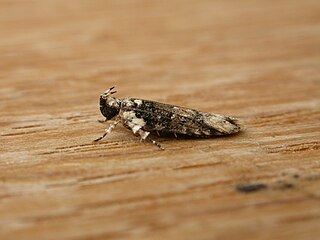
Eupselia satrapella is a species of moth of the family Depressariidae. It is found in Australia, where it has been recorded from Queensland, New South Wales and the Australian Capital Territory.
Ardozyga aversella is a species of moth in the family Gelechiidae. It was described by Francis Walker in 1864. It is found in Australia, where it has been recorded from the states of Western Australia, Queensland, New South Wales, Victoria and South Australia.

Ardozyga sodalisella is a species of moth in the family Gelechiidae. It was described by Francis Walker in 1864. It is found in Australia, where it has been recorded from Queensland and New South Wales.
Cerconota recurrens is a moth of the family Depressariidae. It is found in Bolivia.
Cerconota achatina is a moth of the family Depressariidae. It is found in Colombia, Guyana and French Guiana.
Stenoma platyterma is a moth of the family Depressariidae. It is found in Guyana.
Cerconota eriacma is a moth of the family Depressariidae. It is found in Guyana.
Cerconota languescens is a moth of the family Depressariidae. It is found in Guyana, French Guiana and Brazil.
Cerconota rosacea is a moth of the family Depressariidae. It is found in the Amazon region and French Guiana.
Cerconota fusigera is a moth of the family Depressariidae. It is found in the Guianas and Brazil.
Cerconota impressella is a moth of the family Depressariidae. It is found in Brazil (Para), Peru, and the Guianas.
Cerconota capnosphaera is a moth of the family Depressariidae. It is found in French Guiana.
Cerconota trochistis is a moth of the family Depressariidae. It is found in French Guiana.
Stenoma himerodes is a moth of the family Depressariidae. It is found in French Guiana.
Cerconota fermentata is a moth of the family Depressariidae. It is found in French Guiana.
Uzucha humeralis is a moth in the family Xyloryctidae. It was described by Francis Walker in 1864. It is found in Australia, where it has been recorded from New South Wales and Queensland.
Cerconota tabida is a moth in the family Depressariidae. It was described by Arthur Gardiner Butler in 1877. It is found in the Brazilian states of Amazonas and Pará and in the Guianas.
Cerconota carbonifer is a moth in the family Depressariidae. It was described by August Busck in 1914. It is found in Panama, Costa Rica and French Guiana.
Cerconota recurvella is a moth in the family Depressariidae. It was described by Francis Walker in 1864. It is found in the Guianas, Colombia and Tefé, Brazil.
Imma monocosma is a moth in the family Immidae. It was described by Alexey Diakonoff and Yutaka Arita in 1979. It is found on the Japanese islands of Kyusyu and Honshu.

